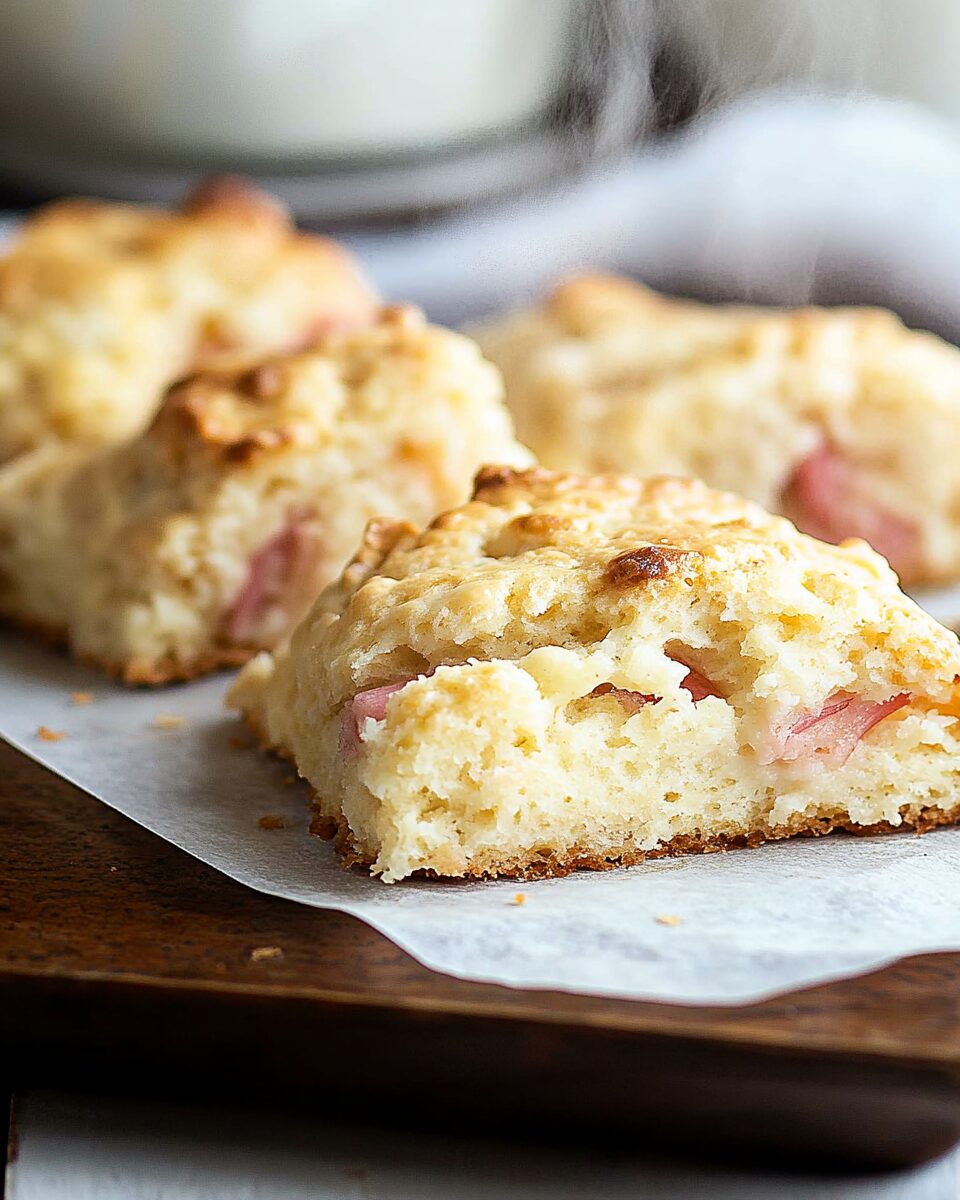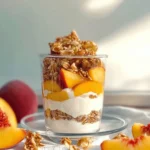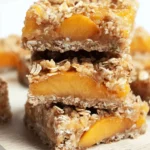A nostalgic treat from grandma’s kitchen, these buttery rhubarb scones are the perfect balance of tender crumb, tangy rhubarb, and a hint of sweetness. Ideal for breakfast or an afternoon snack, they’re quick to prepare and full of comforting flavor.
FULL RECIPE
Ingredients
- 2 cups all-purpose flour
- 1/3 cup granulated sugar
- 1 tablespoon baking powder
- 1/2 teaspoon baking soda
- 1/2 teaspoon salt
- 1/2 cup cold unsalted butter, cubed
- 1 cup chopped fresh rhubarb
- 2/3 cup buttermilk
- 1 teaspoon vanilla extract
- Optional: 1 tablespoon coarse sugar for topping
Directions
- Preheat oven to 400°F (200°C). Line a baking sheet with parchment paper.
- In a large bowl, whisk together flour, sugar, baking powder, baking soda, and salt.
- Cut in cold butter using a pastry cutter or fingertips until mixture resembles coarse crumbs.
- Gently fold in chopped rhubarb.
- In a separate bowl, mix buttermilk and vanilla extract. Add to dry ingredients and stir just until combined.
- Turn dough onto a lightly floured surface and knead gently 3–4 times.
- Pat into a 1-inch thick circle and cut into 8 wedges.
- Place scones on the prepared baking sheet. Sprinkle tops with coarse sugar if using.
- Bake for 18–22 minutes, or until golden brown.
- Cool slightly on a wire rack before serving warm or at room temperature.
Nutritional Information
- Calories: 230
- Fat: 10g
- Saturated Fat: 6g
- Carbohydrates: 32g
- Sugar: 9g
- Fiber: 1g
- Protein: 4g
- Sodium: 260mg
History of Rhubarb Scones
Rhubarb scones have a rich heritage rooted in traditional British baking. Rhubarb, once considered a medicinal plant, found its way into desserts and baked goods as home cooks sought to balance its tartness with sweet, buttery doughs. Over time, rhubarb scones became a beloved treat, especially in spring when fresh rhubarb is at its peak.
Why Use Rhubarb in Scones
Rhubarb’s natural tartness complements the richness of buttery scones, creating a balanced flavor profile. Unlike sweeter fruits, rhubarb adds a refreshing tang that cuts through the fat in the dough, making the scones less heavy and more interesting on the palate.
Choosing Fresh Rhubarb
When selecting rhubarb for scones, choose stalks that are firm and brightly colored, usually red or pink with a slight sheen. Avoid stalks that are wilted, soft, or have blemishes. The leaves of rhubarb are toxic, so only the stalks should be used.
Alternatives to Fresh Rhubarb
In seasons when fresh rhubarb is unavailable, frozen rhubarb is a suitable substitute. It should be thawed and drained well before mixing to avoid excess moisture in the dough. Dried or canned rhubarb is generally not recommended for scones as it lacks the fresh tartness and texture.
The Role of Butter
Butter is crucial for achieving the flaky, tender texture in scones. Using cold, cubed butter ensures it stays in small pockets within the dough, which melt during baking and create layers. This method results in a light, buttery crumb.
Buttermilk’s Impact
Buttermilk adds moisture and a slight tang that enhances the flavor of the scones. Its acidity also reacts with baking soda to help the scones rise properly, creating a soft and airy interior.
Sugar Balance
The amount of sugar in rhubarb scones needs careful balancing. Too much sugar can overpower the rhubarb’s tartness, while too little can make the scones taste bland. A moderate sweetness complements the natural sharpness of the rhubarb perfectly.
Baking Powder and Soda Combination
Using both baking powder and baking soda in scones ensures an optimal rise and texture. Baking powder works as a leavening agent, while baking soda reacts with the acidity in buttermilk, resulting in a tender crumb with good volume.
Mixing Techniques
Overmixing scone dough can develop gluten, leading to tough, dense scones. Gentle folding and minimal kneading are essential to keep the scones light and flaky.
Shaping and Cutting
Shaping the dough into a circle and cutting it into wedges is a traditional approach that encourages even baking and presents a classic look. However, some bakers prefer dropping dough onto sheets for a more rustic style.
Coarse Sugar Topping
Sprinkling coarse sugar on top before baking adds a subtle crunch and a touch of sparkle, enhancing the scones’ visual appeal and texture contrast.
Ideal Baking Temperature
Baking scones at a high temperature (around 400°F or 200°C) is key to achieving a golden crust while keeping the interior soft and moist. The quick bake also helps preserve the delicate rhubarb flavor.
Serving Suggestions
Rhubarb scones are delicious served warm, plain or with butter. They also pair well with clotted cream, honey, or a light glaze made from powdered sugar and lemon juice, which complements the tartness.
Storage Tips
Scones are best enjoyed fresh but can be stored in an airtight container at room temperature for up to two days. For longer storage, freezing is recommended; just reheat gently before serving.
Nutritional Considerations
While rhubarb scones are not low-calorie, they offer a balance of carbohydrates, fats, and a small amount of protein. The rhubarb adds dietary fiber and vitamins such as vitamin K and C, making them a slightly healthier indulgence.
Common Variations
Some variations include adding spices like cinnamon or ginger, substituting white sugar with brown sugar for deeper flavor, or mixing in other fruits like strawberries or blueberries to complement the rhubarb.
Cultural Significance
In many regions, rhubarb symbolizes spring and renewal because it is one of the first harvestable plants. Scones with rhubarb often appear at seasonal gatherings, afternoon teas, and family celebrations.
Pairing with Beverages
These scones pair wonderfully with tea varieties such as Earl Grey or chamomile. Coffee lovers may also enjoy them with a mild roast. The tartness of rhubarb contrasts nicely with creamy or floral drinks.
Tips for Perfect Texture
Using chilled ingredients, avoiding overmixing, and maintaining a thick dough help achieve the ideal crumb. Resting the dough briefly before baking can also improve texture by allowing flour to hydrate evenly.
Environmental Impact
Using locally sourced rhubarb and organic butter can reduce the environmental footprint of this recipe. Seasonal baking supports sustainable practices by encouraging the use of fresh, regional ingredients.
Conclusion
Buttery rhubarb scones remain a timeless recipe cherished for their delightful balance of tangy fruit and rich, flaky pastry. Their simplicity and elegance make them a favorite in both casual breakfasts and special occasions. By understanding the ingredients and techniques that create their unique texture and flavor, home bakers can master this classic treat. Whether enjoyed fresh from the oven or paired with a warm beverage, rhubarb scones continue to bring comfort and a touch of nostalgia to the table.






